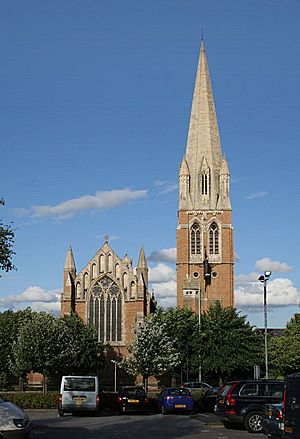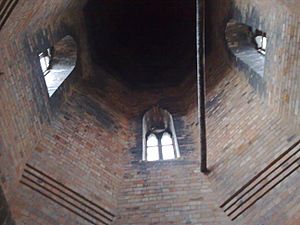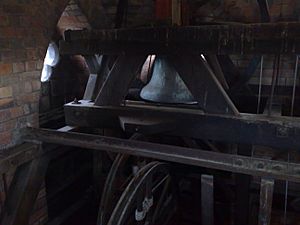St Paul's Church, Daybrook facts for kids
Quick facts for kids St. Paul’s Church, Daybrook |
|
|---|---|
 |
|
| Denomination | Church of England |
| Churchmanship | High Church |
| Website | https://www.achurchnearyou.com/parish/380287/ |
| History | |
| Dedication | St. Paul |
| Administration | |
| Parish | Daybrook |
| Diocese | Southwell and Nottingham |
| Province | York |
The Church of St. Paul is a special parish church in Daybrook, Nottingham. It is part of the Church of England. You can find it on Mansfield Road. The church also includes the St Timothy church centre.
St. Paul's Church is a very important building. It is called a Grade II* listed building. This means it is a significant building with a lot of history.
Contents
The History of St. Paul's Church
A famous architect named John Loughborough Pearson designed St. Paul's Church. He worked on the plans between 1892 and 1896. Building the church started in May 1893. J W Woodsend was in charge of the construction.
The main part of the church was finished in December 1895. It was officially opened on February 4, 1896. The church was dedicated to Paul the Apostle. You can see pictures of him in the church's stained glass windows.
The tower and a tall spire were added in 1897. The spire reaches a height of 150 feet (about 46 meters). The whole church cost about £26,000 to build. This was a lot of money back then! Sir Charles Seely paid for the entire building.
Beautiful Stained Glass Windows
The church has amazing stained glass windows. These windows were made by a company called Clayton and Bell. They show different parts of the life and work of Saint Paul. Stained glass uses colorful pieces of glass to create pictures.
The Church Bells
There are eight large bells in the church tower. These bells were made in London by Mears and Stainbank. They were cast in 1897, the same year the spire was finished. Church bells are often rung to call people to worship.
The Church Organ
The church has a large musical instrument called an organ. It was built by Augustus Gern in 1896. This organ has two keyboards, called manuals. It also has twenty-four different sounds, called stops. The organ is located in the north chancel aisle. Its wooden case is beautifully carved with delicate designs.



